A simple and versatile homemade fresh pasta dough recipe that can be used to make anything from spaghetti to lasagna to ravioli.
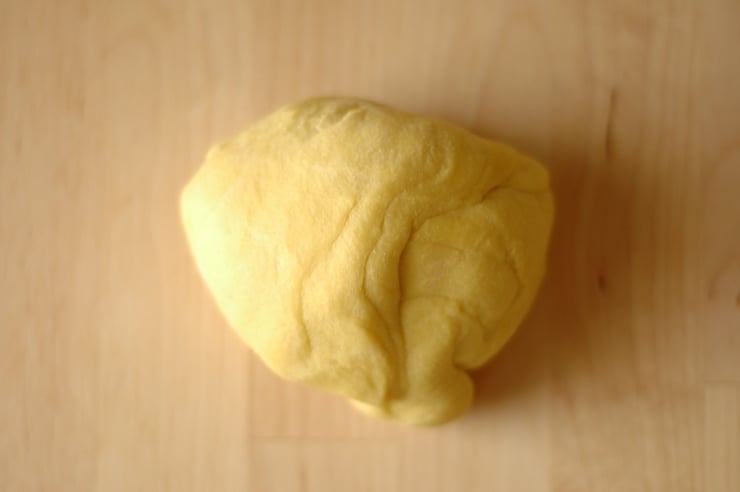
I have a confession to make. I am a pasta addict. There! An addict I tell you! And I am not ashamed to admit it. I am addicted to all things pasta. And there is one person to blame for this addiction- my late grandfather, William! Yes, he is the man who brought some Italian roots (roots that we don’t even have, mind you!) into my blood. Once I was able to taste his famous pasta dishes with this homemade fresh pasta dough recipe, I was hooked on the stuff.
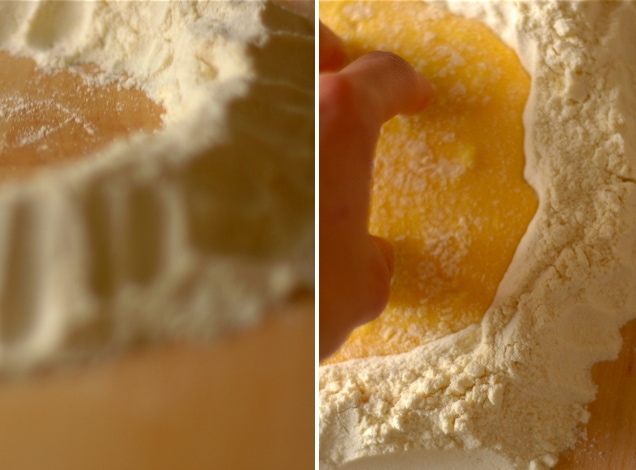
Whenever my grandparents would visit us, guess who asked for Grandpa William’s pasta dish (which sadly has no name… He would just call it “es-Spaghetti” with his thick Spanish accent)? Yes,- ME!
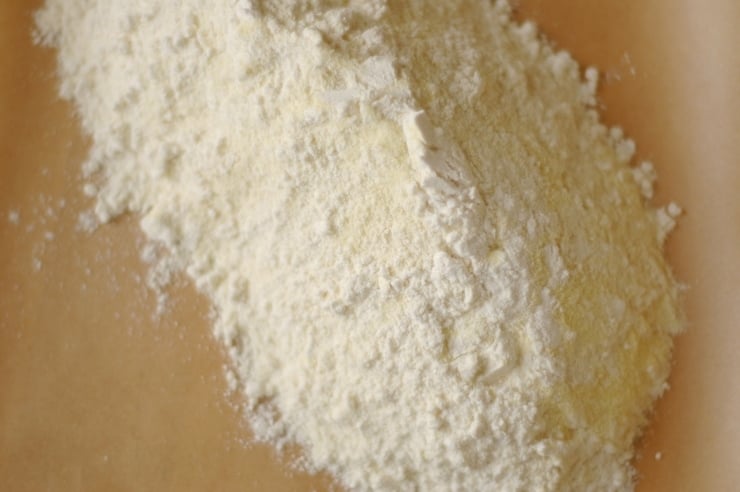
My grandfather was a firm believer in putting love into all of his dishes. And when he could make something from scratch to save a penny (and to make things taste better!), he’d do it. He’d make his own pasta dough from scratch, and roll it by hand.
Up until March of this year, I have been rolling out pasta dough by hand, just as my grandfather used to. And boy, can I tell you how much of a hassle that was! From kneading the dough, to getting the dough super thin would take forever, even when using the best techniques.
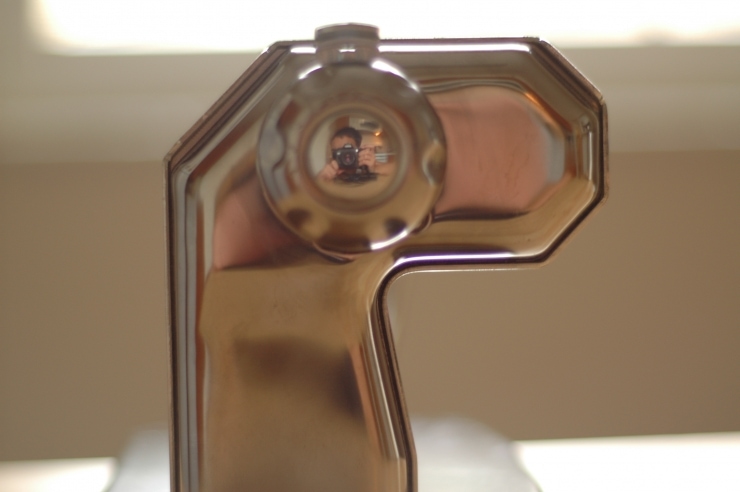
Luckily, recently, I was approached by Ashley of CSN. She asked if I was willing to review one of their products from one of their 200+ online stores. I had taken a look around one of their online stores and found something that I knew would have mixed reviews about- A pasta machine that I had been drooling over for a while!
About pasta machines
Pasta Machines are pretty straight forward, but when you are making pasta after a while on the machine, you’ll start to know the pros and cons of it all. So, as promised, I will do a brief review, while still talking about pasta. I promise, I won’t try to bore you with the review section of this post.
So, what do I think of this machine? It’s absolutely perfect! It does what I want it to! AND it comes with a double cutter for spaghetti and fettuccine (which I have used successfully). The machine works like a charm and is very durable and reliable.
One con I have noticed about this machine (after making pasta about 15 times in it!), is the dial that switches to different settings. It’s pretty darn slippery when you’re trying to turn it with flour on your fingers, otherwise, I’d highly suggest purchasing this pasta machine.
Now, back to the pasta!
Where was I… Oh, rolling pasta by hand…
Rolling fresh pasta dough by hand
So, when rolling pasta by hand, I have learned that using only semolina flour to make your dough is going to kill you and will make you want to cry. Semolina flour is very high in gluten and will result in a very glutenous dough that will be extremely difficult to handle especially when it’s sticking all over the place (even when you flour surfaces well!). Now, if you have one of those facy schmancy machines like I have now, using a pasta dough that’s made only from semolina will be easy to roll out because you’re not breaking your back trying to roll super-tough dough with a rolling pin.
BUT!
Yes, there’s always a but!
Even though you have a machine to roll that 100% semolina flour dough, it’s still likely to stick, and getting sticky dough off of pasta rollers is not fun! Trust me.
Ingredients for homemade fresh pasta
- Most homemade pasta doughs are quite basic, and they often lack in flavor. This homemade fresh pasta dough recipe is packed with lots of flavor and an unexpected ingredient like white wine!
- Flour – you’ll need both all-purpose and semolina flour. This makes for the most perfect combination for rich homemade pasta dough.
- Eggs – and you’ll need lots of them. You’ll need 6 egg yolks and 1 whole egg. This makes a rich, flavorsome, and malleable pasta dough.
- Olive oil- are we making Italian food without this ingredient? Extra virgin is okay here; you want something that tastes good as you’ll taste it once the fresh pasta dough is cooked
- Milk or dry white wine – one or the other; only a small amount. I prefer using white wine. It adds flavor to the dough that is so pleasantly unexpected. Go for something you’d like to drink; I prefer to use a Pinot Grigio here.
How to make fresh pasta dough
So, for this pasta dough “recipe,” I have turned a great Thomas Keller recipe into something that I personally feel is a wee bit greater. How? I used a mixture of All-Purpose Flour and, yes, Semolina Flour. It results in a perfect, strong pasta dough full of flavor that regular ‘ol All-Purpose flour doesn’t give you, even when the recipe does call for seven yolks! Additionally, Thomas Keller calls for using a tablespoon of milk in his original recipe, if you have some dry white wine around (i.e. Pinot Grigio), feel free to use that instead of milk- it will give the dough a little pizazz!
Other Recipes You Will Love
Pasta Dough Recipe

Who said that pasta dough making has to be difficult? It so isn’t! All you need is a bit of patience, the right ingredients, and a bit of upper body strength, and you’ll be on your way to pasta making heaven!
Ingredients
- 2/3 Cups + 1 tablespoon /110 g All-Purpose Flour
- 1/2 Cup + 2 tablespoons / 110 g Semolina Flour
- 6 large egg yolks
- 1 large egg
- 1 ½ teaspoons olive oil
- 1 tablespoon milk or dry white wine (i.e. Pinot Grigio)
- Extra All-Purpose Flour for kneading
Instructions
- Mound the flour on a board or other surface and create a well in the center, pushing the flour to all sides to make a ring with sides about 1 inch wide. Make sure that the well is wide enough to hold all the eggs without spilling.
- Pour the egg yolks, egg, oil, and milk into the well. Use your fingers to break the eggs up. Still using your fingers, begin turning the eggs in a circular motion, keeping them within the well and not allowing them to spill over the sides. This circular motion allows the eggs to gradually pull in flour from the sides of the well; it is important that the flour not be incorporated too rapidly, or your dough will be lumpy.
- Keep moving the eggs while slowly incorporating the flour. Using a pastry scraper, occasionally push the flour toward the eggs; the flour should be moved only enough to maintain the gradual incorporation of the flour, and the eggs should continue to be contained within the well. The mixture will thicken and eventually get too tight to keep turning with your fingers.
- When the dough begins thickening and starts lifting itself from the board, begin incorporating the remaining flour with the pastry scraper by lifting the flour up and over the dough that’s beginning to form and cutting it into the dough. When the remaining flour from the sides of the well has been cut into the dough, the dough will still look shaggy.
- Bring the dough together with the palms of your hands and form it into a ball. It will look flaky but will hold together.
- Knead the dough by pressing it, bit by bit, in a forward motion with the heels of your hands rather than folding it over on itself as you would with a bread dough. Re-form the dough into a ball and repeat the process several times. The dough should feel moist but not sticky. Let the dough rest for a few minutes while you clean the work surface.
- Dust the clean work surface with a little flour. Knead the dough by pushing against it in a forward motion with the heels of your hands.
- Form the dough into a ball again and knead it again. Keep kneading in this forward motion until the dough becomes silky-smooth. The dough is ready when you can pull your finger through it and the dough wants to snap back into place. The kneading process can take anywhere from 10 to 15 minutes. Even if you think you are finished kneading, knead it for an extra ten minutes; you cannot overknead this dough. It is important to work the dough long enough to pass the pull test; otherwise, when it rests, it will collapse.
- Double-wrap the dough in plastic wrap to ensure that it does not dry out. Let the dough rest for at least 30 minutes and up to 1 hour before rolling it through a pasta machine. The dough can be made a day ahead, wrapped and refrigerated; bring to room temperature before proceeding.
Notes
Adapted from Thomas Keller via Epicurious, 1999
Nutrition Information:
Yield:
4Serving Size:
1Amount Per Serving: Calories: 356Total Fat: 12gSaturated Fat: 3gTrans Fat: 0gUnsaturated Fat: 7gCholesterol: 372mgSodium: 127mgCarbohydrates: 42gFiber: 2gSugar: 0gProtein: 18g


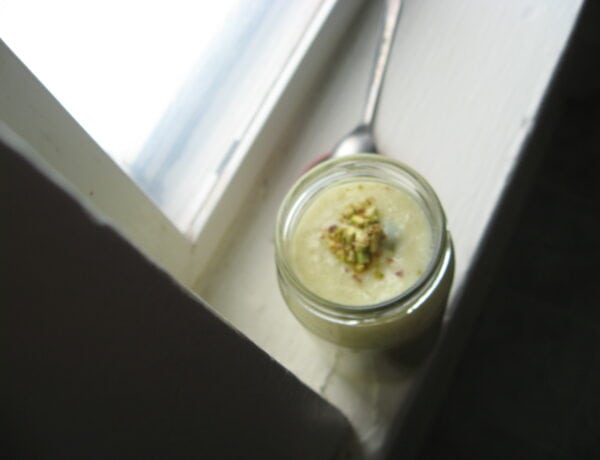
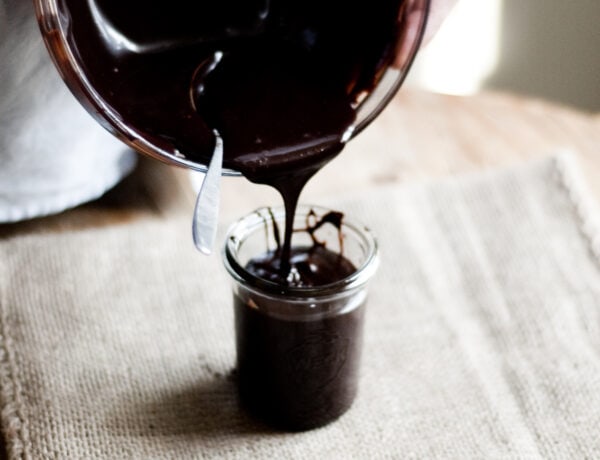
72 Comments
Linda's Yummies
May 19, 2010 at 9:20 pmAlways wanted to make fresh pasta. Thanks for sharing. I can’t wait for the weekend to try this out :)
Bruce
May 21, 2010 at 11:16 pmAlways wanted to make fresh pasta. Thanks for sharing. I can’t wait for the weekend to try this out :)
More Than Gourmet
May 28, 2010 at 3:37 pmThis looks amazing. Reminds me of this great basil recipe, a yummy summertime dish:
http://www.morethangourmet.com/our-family-recipes/basil-sauce-for-pasta
FrenchPressMemos
June 2, 2010 at 8:54 pmWe ( and by that I mean my husband) made pasta tonight! No pasta maker. Well, he is the pasta maker! I posted the recipe we use a while back on my blog but it is essentially all semolina. He uses an Alice Waters recipe from the Chez Panisse Cafe Cookbook and it is divine. I am NOT a pasta addict- at all- but his pasta is like nothing you buy at the store.
Angela@spinachtiger
June 13, 2010 at 3:10 pmIt’s awesome to be making pasta so young. I think I wrote this to you before. I have very good luck with semolina flour. You must put it through the food processor and make it as light as possible and then be sure to rest it wrapped in plastic. If it is too sticky, then the egg amount is off. Simply add in more flour, a tiny bit at a time. It’s all about the feel. I write this because of everything I have tried, I stand by semolina being the very best flour for pasta that will have body to it and not end up being simply egg noodles.
I love your pictures and your passion.
joanne
June 14, 2010 at 10:21 amWhat a wonderful recipe! My reluctance in making my own pasta is cleaning the machine. I’ve heard that it can be quite tedious. I know the difference in taste between homemade and pre-packaged is not to be compared but I guess I’d like a little more reassurance that the clean up will be just as easy as making the mess.
Great post and, if I muster up the courage, I’ll try it.
Angela@spinachtiger
June 15, 2010 at 7:04 amKamran
I’m still thinking about your pasta dough. In my comment, I meant you take the semolina flour through the food processor because it’s hard to find it fine enough. I buy mine at Whole Foods. And, another thing I thought of today is to eliminate every other egg white. The whites are protein and can cause toughness.
Sylvia
July 3, 2010 at 11:13 amI like making homemade pasta for homemade chicken noodle soup in the crock pot. yeah.. the noodles take a while to make, but they are so worth it! I can’t wait to try your recipe. Kudos.
-Sylvia
Digital Kitchen Scale
Salvatore Timberman
January 7, 2011 at 10:20 amThere is no doubt that you are a good individual – this is really a terrific write-up! Thanks for sharing.
Justin Francis Kane
February 25, 2011 at 8:27 amwhat’s the cook time for the pasta? and do you ever save it or dry it?
kamran
February 25, 2011 at 8:41 amHi Justin, the cooking time really depends on what you are making the pasta dough into. For spaghetti and fettucini I would say 1-2 minutes is a good call. I personally have not tried drying the pasta because I always end up using it all before I have anything left. As for saving it- same answer; I rarely end up with anything left. I am sure that it will last up to a couple days in the refrigerator (tightly sealed with plastic wrap, of course!) or it would store perfectly in the freezer (once again, sealed well to protect against freezer burn) for a while– just thaw it before deciding to use it.
ryan97ou
February 28, 2011 at 12:59 ami tried TK’s recipe tonight and even though i followed everything to the T, the dough seemed to be too dry and was breaking apart as i was trying to put it through my pasta machine. I let it sit overnight in the fridge (double wrapped in plastic), which he said should be fine, but it still didn’t come out right.
guess i’ll try tomorrow, and maybe add a bit more egg white if it looks like its too dry.
not sure what happened as every blog i’ve read seemed to have no problem with his recipe. thanks for the post and maybe i’ll try semolina next time (i’ve successfully used it before, but not with keller’s 7-yolk recipe).
Eddie Boersma
June 21, 2011 at 1:29 pmI wanted to try this at my house but i couldn’t bc my mom said i couldn’t
Gloria Jean
December 31, 2012 at 1:03 pmI have been making homemade pasta for about 2 years now and have my machine. I have tested many recipes, even some with no eggs. I see that you use both semolina and APF. I use the 00 Flour and wondering if I should purchase the wheat semolina flour. Mix those two together and see what I come out with. I find both flours on E-bay. I do believe that commercial pasta is made with semolina pasta, so this is why I want to use this in my recipe. But my question is, is all all semolina flour made with wheat??? This flour I am buying is Antimo Caputo Durum Wheat and it comes from Italy and I will be mixing it with the Caputo tipo 00 flour. How many eggs should I use or egg yolks, whites? I am looking for a great tasting pasta with a great texture. What do you think I should do? Any help would be greatly appreciated. Love your website, and your passion in the way you made your pasta, love and passion must be used in everything we cook or bake, your grandfather is right.
Kamran
December 31, 2012 at 11:06 pmHi Gloria Jean- Most semolina flour is derived from durum wheat, however, the term “semolina” is also used to describe other forms of wheat and other grains like rice and corn. The semolina you need is the one made of durum wheat, so the one you’re buying is absolutely perfect for the job! As for eggs… I’ve seen that most people will use 1 egg for every cup of flour. However, as mentioned in the above comments by Angela of Spinach Tiger– egg whites tend to toughen the pasta dough, so if you’d prefer a rich pasta dough that isn’t tough; maybe 2 egg yolks for every cup of flour? If you’re using 00 flour, I suspect you can just substitute that for the all-purpose flour called for in the recipe above! I hope that helps! :)
Pip
August 13, 2013 at 3:58 pmI have made pasta for years but I have a niggly problem; whilst making tagliatelle easily when I use the spagetti edge this crimps the pasta. I can’t get long silky smooth threads as I do with the tagliatelle. Can you tell me what I’m doing wrong?
Thanks for the blog
rachel
March 21, 2015 at 10:14 amI use dry pasta cause it is cheap and I don’t want to buy the machine to make it. But it looks fun to make.
Debbie
January 23, 2016 at 4:30 pmEver attempted a copycat version of the BarillaPlus pasta? I’d love to be able to make my own high protein pasta.
Amphasis
May 7, 2018 at 11:48 amNice recipe, shall try to make it for my kids, they love pasta.
C Denise Zahrn
November 25, 2019 at 10:37 amMy Midwest roots mother taught me to use 3 yolks and a whole egg (gotta be brown), 5 drops yellow food color, 2T cream, cup and half of flour, give or take. She did not do refrigeration but rolled out immediately. Her noodles are delish! I do the refrigerate then room temp method now.
Hema
February 9, 2021 at 5:49 amThanks For Sharing this Amazing Recipe. My Family Loved It. I will be sharing this Recipe with my Friends. Hope They will like it.
Rosalinda Munoz
October 26, 2021 at 4:39 amNever knew to use just yolks for pasta ! I have been doing it all my life with 1 egg per cup of flour, this is what I learned from my parents. Once the spaguetties are cut in the pasta machine I hung them in a clothes line until dry and what amount I do t use straightaway I keep it on a spaghetti container, but you must dry them 100% before.